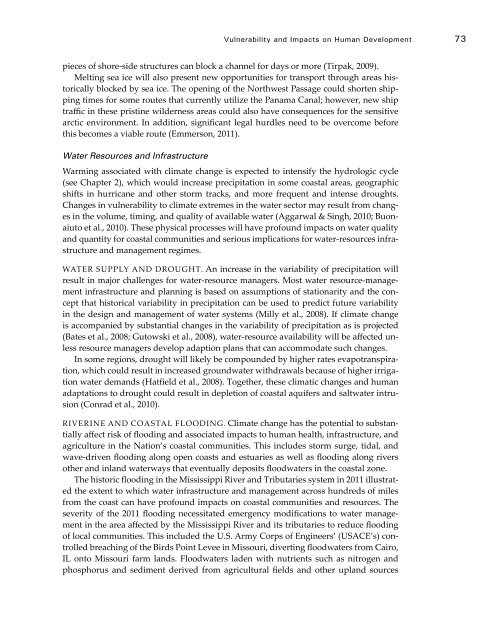Coastal Impacts, Adaptation, and Vulnerabilities - Climate ...
Coastal Impacts, Adaptation, and Vulnerabilities - Climate ...
Coastal Impacts, Adaptation, and Vulnerabilities - Climate ...
You also want an ePaper? Increase the reach of your titles
YUMPU automatically turns print PDFs into web optimized ePapers that Google loves.
Vulnerability <strong>and</strong> <strong>Impacts</strong> on Human Development 73pieces of shore-side structures can block a channel for days or more (Tirpak, 2009).Melting sea ice will also present new opportunities for transport through areas historicallyblocked by sea ice. The opening of the Northwest Passage could shorten shippingtimes for some routes that currently utilize the Panama Canal; however, new shiptraffic in these pristine wilderness areas could also have consequences for the sensitivearctic environment. In addition, significant legal hurdles need to be overcome beforethis becomes a viable route (Emmerson, 2011).Water Resources <strong>and</strong> InfrastructureWarming associated with climate change is expected to intensify the hydrologic cycle(see Chapter 2), which would increase precipitation in some coastal areas, geographicshifts in hurricane <strong>and</strong> other storm tracks, <strong>and</strong> more frequent <strong>and</strong> intense droughts.Changes in vulnerability to climate extremes in the water sector may result from changesin the volume, timing, <strong>and</strong> quality of available water (Aggarwal & Singh, 2010; Buonaiutoet al., 2010). These physical processes will have profound impacts on water quality<strong>and</strong> quantity for coastal communities <strong>and</strong> serious implications for water-resources infrastructure<strong>and</strong> management regimes.Water SUPPLY <strong>and</strong> Drought. An increase in the variability of precipitation willresult in major challenges for water-resource managers. Most water resource-managementinfrastructure <strong>and</strong> planning is based on assumptions of stationarity <strong>and</strong> the conceptthat historical variability in precipitation can be used to predict future variabilityin the design <strong>and</strong> management of water systems (Milly et al., 2008). If climate changeis accompanied by substantial changes in the variability of precipitation as is projected(Bates et al., 2008; Gutowski et al., 2008), water-resource availability will be affected unlessresource managers develop adaption plans that can accommodate such changes.In some regions, drought will likely be compounded by higher rates evapotranspiration,which could result in increased groundwater withdrawals because of higher irrigationwater dem<strong>and</strong>s (Hatfield et al., 2008). Together, these climatic changes <strong>and</strong> humanadaptations to drought could result in depletion of coastal aquifers <strong>and</strong> saltwater intrusion(Conrad et al., 2010).Riverine <strong>and</strong> COASTAL FLOODING. <strong>Climate</strong> change has the potential to substantiallyaffect risk of flooding <strong>and</strong> associated impacts to human health, infrastructure, <strong>and</strong>agriculture in the Nation’s coastal communities. This includes storm surge, tidal, <strong>and</strong>wave-driven flooding along open coasts <strong>and</strong> estuaries as well as flooding along riversother <strong>and</strong> inl<strong>and</strong> waterways that eventually deposits floodwaters in the coastal zone.The historic flooding in the Mississippi River <strong>and</strong> Tributaries system in 2011 illustratedthe extent to which water infrastructure <strong>and</strong> management across hundreds of milesfrom the coast can have profound impacts on coastal communities <strong>and</strong> resources. Theseverity of the 2011 flooding necessitated emergency modifications to water managementin the area affected by the Mississippi River <strong>and</strong> its tributaries to reduce floodingof local communities. This included the U.S. Army Corps of Engineers’ (USACE’s) controlledbreaching of the Birds Point Levee in Missouri, diverting floodwaters from Cairo,IL onto Missouri farm l<strong>and</strong>s. Floodwaters laden with nutrients such as nitrogen <strong>and</strong>phosphorus <strong>and</strong> sediment derived from agricultural fields <strong>and</strong> other upl<strong>and</strong> sources
















